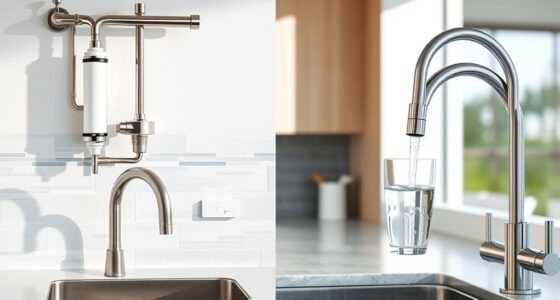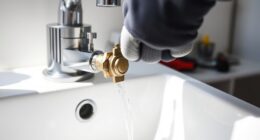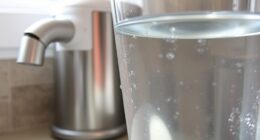To keep your UV disinfection system working effectively, regularly replace the UV lamps based on manufacturer guidelines, usually every 9-12 months, even if they still glow. Clean the quartz sleeves to remove any buildup that blocks UV light. Monitor water or air flow to guarantee it stays within ideal ranges, preventing shadowing. Check and replace electrical components like ballasts to avoid flickering or failures. Routine inspections and proper record keeping will catch issues early—continue exploring these tips to master maintenance.
Key Takeaways
- Regularly replace UV lamps according to manufacturer guidelines to maintain effective UV intensity.
- Keep quartz sleeves clean to ensure unobstructed UV light transmission.
- Monitor water or air flow to stay within optimal ranges, preventing disinfection inefficiencies.
- Check and replace electrical components like ballasts to ensure consistent UV output.
- Conduct routine inspections and maintain detailed records to catch issues early and prolong system lifespan.
Regularly Replace the UV Lamps
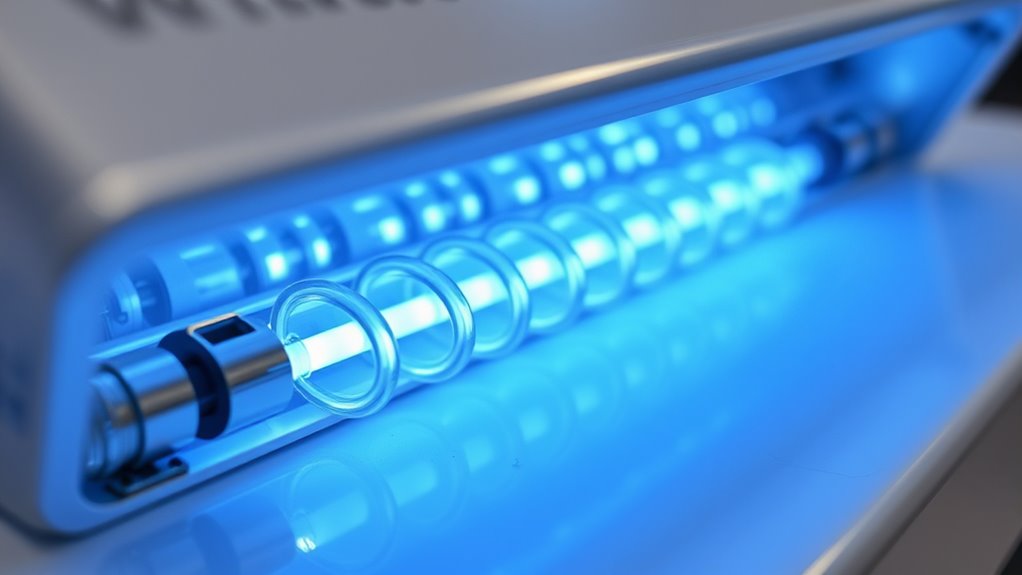
To guarantee your UV disinfection system remains effective, you need to regularly replace the UV lamps. The UV lamp lifespan typically ranges from 9 to 12 months, depending on usage and manufacturer guidelines. Ignoring this schedule can lead to diminished UV intensity, reducing the system’s ability to disinfect properly. Establishing a lamp replacement schedule helps assure consistent performance and prevents unexpected failures. Mark your calendar or set reminders to check and replace the lamps on time. Keep in mind that even if a lamp still lights up, its UV output may have weakened, so timely replacement is vital. Regular maintenance also involves inspecting the lamp power output to ensure optimal disinfection results. Staying on top of your lamp replacement schedule guarantees peak disinfection and protects your water quality effectively.
Keep the Quartz Sleeves Clean

Keeping the quartz sleeves clean is essential for maintaining the effectiveness of your UV disinfection system. Regular quartz sleeve cleaning ensures that UV light passes efficiently through the sleeves without obstruction, maximizing disinfection performance. During sleeve inspection, look for signs of fouling, mineral deposits, or cloudiness that can reduce UV transmittance. Use appropriate cleaning methods, such as gentle scrubbing with a soft cloth or brush and a suitable cleaning solution, avoiding abrasive materials that could scratch the quartz. Always handle the sleeves carefully to prevent damage. Regular maintenance can also prevent issues related to GMC tuning, ensuring your system continues to operate optimally. Consistently inspecting and cleaning the quartz sleeves keeps your UV system functioning at its best, reduces maintenance issues, and prolongs component lifespan. Remember, clean sleeves mean more effective disinfection and safer water or air quality.
Monitor and Maintain Proper Water or Air Flow

Ensuring proper water or air flow is vital for the effectiveness of your UV disinfection system. You need to monitor the flow rate regularly to guarantee it stays within the system’s ideal range. Too high or too low flow rates can reduce UV exposure, compromising disinfection. System calibration is essential; it helps confirm the flow sensors and gauges are accurate. Regularly check and adjust these settings to maintain consistent flow. Keep in mind that changes in flow rate can impact UV dose, so staying vigilant guarantees maximum performance. Proper flow management prevents UV shadowing and ensures the microbes receive the intended UV exposure. Consistent monitoring and calibration help maintain the system’s effectiveness and extend its lifespan. Additionally, understanding air purification technology can help optimize system setup for better disinfection results.
Check and Replace Ballasts and Electrical Components
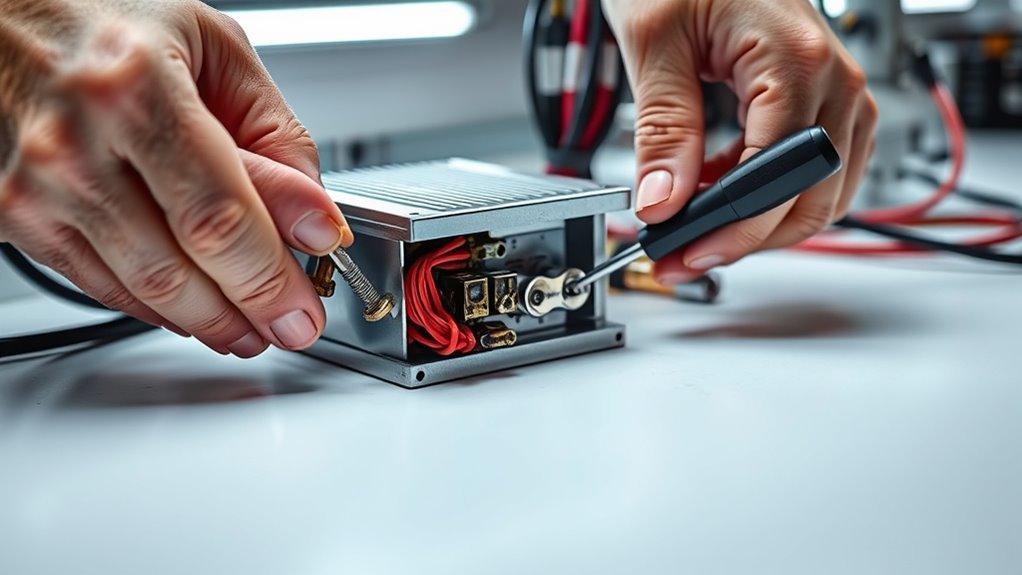
Regularly checking and replacing ballasts and electrical components keeps your UV disinfection system running reliably. Start with ballast testing to ensure they operate at proper voltage and avoid flickering or reduced UV output. If you notice dimming or inconsistent performance, it’s time for replacement. During electrical troubleshooting, inspect wiring connections for corrosion, loose contacts, or damage. Faulty electrical parts can cause system failures or decreased UV effectiveness. Replace worn or damaged components promptly to prevent downtime. Always turn off power before servicing, and use appropriate tools for testing and replacement. Keeping electrical components in good condition guarantees your UV system functions efficiently, maintaining disinfection standards and extending the lifespan of your equipment. Regular maintenance saves you time and costly repairs later. Additionally, staying aware of AI vulnerabilities can help identify potential system issues early, ensuring your UV disinfection remains effective.
Conduct Routine System Inspections and Record Keeping

By conducting routine system inspections, you can identify potential issues early before they lead to system failure or reduced disinfection effectiveness. Regular inspections help guarantee the UV system remains properly calibrated, maintaining ideal performance. Keep detailed records of each inspection, noting system calibration status, bulb condition, and electrical components. Proper record keeping allows you to track trends, spot recurring problems, and schedule timely maintenance. It also supports staff training by providing a clear history of system performance and maintenance activities. Encourage staff to follow a checklist during inspections, emphasizing calibration verification and component integrity. Consistent inspections and thorough documentation help you catch issues early, extend equipment lifespan, and ensure the system consistently delivers effective UV disinfection. Additionally, understanding the importance of proper maintenance can significantly impact the longevity and efficiency of your UV system.
Frequently Asked Questions
How Often Should I Calibrate UV Intensity Meters?
You should calibrate your UV intensity meters at least once every six months to guarantee accurate readings. Regular UV intensity calibration is vital for effective disinfection, so incorporate this into your maintenance scheduling. If your UV system operates continuously or in demanding environments, consider calibrating every three to four months. Keeping your UV meters properly calibrated guarantees peak performance and safety, preventing under- or over-exposure during disinfection processes.
What Are the Signs of UV System Failure?
You’ll know your UV system is failing if you notice a decrease in water quality or cloudy output, indicating insufficient disinfection. The UV system lifespan is vital; once it nears the end, UV bulb replacement becomes necessary. Other signs include irregular lamp flickering, unusual noises, or error alerts. Regular maintenance and monitoring help you catch failures early, ensuring your UV system continues to operate effectively.
Can UV Disinfection Systems Be Used for All Water Types?
Imagine treating a wastewater sample with a UV disinfection system; it works well when water contamination levels are moderate. UV systems can handle various water types, but their effectiveness depends on water clarity and contamination. For example, turbid water reduces UV penetration, shortening system lifespan and decreasing disinfection efficiency. So, while you can use UV for many water types, assess water quality first to guarantee best performance and longevity.
How Do I Troubleshoot Uneven UV Light Distribution?
To troubleshoot uneven UV light distribution, start by checking for UV lamp aging, which can cause uneven output. Make sure the quartz sleeve is clean, as dirt or mineral buildup blocks UV transmission. Inspect the lamp for proper alignment and replace it if it’s nearing the end of its lifespan. Regular cleaning and timely lamp replacement help maintain consistent UV intensity, ensuring even disinfection across the entire system.
What Safety Precautions Are Essential During Maintenance?
Did you know UV exposure can cause serious skin and eye injuries? During maintenance, prioritize UV safety by always wearing protective gear like gloves and goggles. Keep the UV system off and unplugged before inspecting or cleaning components. Follow maintenance precautions closely, guaranteeing no accidental exposure occurs. Never bypass safety interlocks, and work in well-lit areas. These steps protect you and ensure your UV disinfection system functions safely and effectively.
Conclusion
By following these five UV disinfection maintenance rules, you’ll keep your system running efficiently and effectively. Regularly replacing lamps and cleaning quartz sleeves can boost performance by up to 30%. Monitoring flow and electrical components prevents costly breakdowns. Remember, routine inspections and record-keeping guarantee longevity and safety. Staying proactive is key—think of it like maintaining a car; neglecting it can lead to a 50% decrease in efficiency over time. Keep up, and stay protected!




